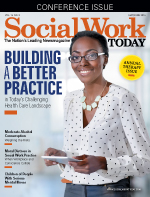|
Addictions Advisor: Substance Use and Intervention at Colleges and Universities For many young adults, "the college experience" entails varying realms of experience with alcohol or other substances, and national statistics show variations over time in categories of use. Colleges and universities continually reinvent and reinvest in strategies to deal with the seemingly intractable problems associated with substance abuse. Researchers estimate that the following happen each year: Patrick Gilligan, LISW, director of counseling services at Kenyon College in Gambier, Ohio, notes that "Since research indicates that most students start using alcohol in the first year of college, colleges find themselves in the unique position of helping students with an introduction to responsible alcohol use without sanctioning it" (as the majority of undergraduates are under the legal drinking age of 21). To that end, he states that Kenyon takes an aggressive approach to delivering education through relationships. Among several programs, Kenyon has 150 students (10% of the student body) who are trained as peer educators and understand the resources for substance use treatment on campus. "Research shows us that students are more likely to divulge their problems to other students," Gilligan says. "Therefore, we work very closely with these groups to convey that issues that affect college students are real, invariable, and can be made better with support." Michael Durham, LSW, LICDC, substance abuse counselor at Kenyon, explains the college's Good Samaritan policy. This policy allows a student (or peer) to call the campus safety service to respond to and assess a student when there is concern that the student may be at risk of alcohol poisoning, acute intoxication from another substance, or other imminent harm. Students acting under the Good Samaritan policy are not subject to disciplinary action, and Durham meets with any student who uses this service for an individual session. This policy exemplifies the delicate balance of prioritizing safety without condoning dangerous binge drinking, which Durham believes is the most critical challenge facing colleges related to substance abuse. Other Substance Use To put the increase in marijuana use in perspective, Lloyd Johnston, principal investigator of the MTF study, notes, "This is the highest rate of daily use observed among college students since 1981—one-third of a century ago. In other words, one of every 20 college students was smoking pot on a daily or near-daily basis in 2013, including one in every 11 males and one in every 34 females" (Wadley). The Addictions Recovery Model Raleigh believes colleges have an opportunity to broaden intervention strategies while still holding students accountable for their actions. "Addiction patterns solidify in early adulthood, around ages 18, 19, 20, when students are often away from home for the first time and protective factors in their lives are shifting. Instead of dealing with substance use issues primarily as violations of the student code of conduct or through the legal system, I think colleges would serve students well to incorporate an addictions recovery model into the conduct process." Research published in Alcoholism: Clinical and Experimental Research supports this approach. In sum, researchers surveyed how campus and local security responded to serious, less serious, and underage alcohol-related incidents both on and off campus. According to an article summarizing the findings, "It was also not typical for these students to be referred to a campus health center to be evaluated for a possible alcohol problem. Rather, students were usually referred for discipline or sanctions to other university officials" (Swartz, 2014). Raleigh describes the "Be Brave" Recovery Community model at UNCP, which is part of a growing trend at colleges and universities across the country, notably in the University of Texas system. Transforming Youth Recovery, a nonprofit created by the Stacie Mathewson Foundation, accelerates this trend by providing an asset-based model as the basis for building collegiate recovery capacity, as well as grants to institutions to aid in the start-up costs. UNCP is a grantee of Transforming Youth Recovery. Transforming Youth Recovery According to Raleigh, "We've spent a lot of money (in higher education) on prevention over the years, and the large-scale efficacy of our prevention work is just not there. Of course, we continue our prevention efforts, but at UNCP, we are not putting all our eggs in the prevention basket. We are expanding our treatment and recovery programs." Given the complex problems associated with the pervasive use of alcohol, marijuana, and other drugs among young adults, colleges and universities are bound to grapple with best practices in helping students cope with the harmful effects. Multipronged approaches including prevention interventions and treatment resources, as well as effective support for college students in recovery, are integral to a broadening access to a successful college experience for more students. — Liza Greville, MA, LCSW, is in full-time clinical practice and a contributor to Social Work Today. Swartz, J. (2014, July 21). Colleges can be doing more to combat drinking culture, study says. USA TODAY College website. Retrieved from http://college.usatoday.com/2014/07/21/colleges-can-be-doing-more-to-combat-drinking-culture-study-says/. Wadley, J. (2014, September 8). College students' use of marijuana on the rise, some drugs declining. University of Michigan website. Retrieved from http://ns.umich.edu/new/releases/22362-college-students-use-of-marijuana-on-the-rise-some-drugs-declining.
|

 May/June 2016 Issue
May/June 2016 Issue